#theres a thread there… i Know there is…
Explore tagged Tumblr posts
Text
Is it safe to continue? Man, a part of him fears that it won't be. But with no signs of the rats anywhere, and already knee deep in this labyrinthian place, there really was only one direction but forward, right?
Still, as Hugh continues, he takes it slowly. "...furballs like that should not be nearly putting us in the infirmary!" He laughs it off, just like, man, what in the world was all of this? Did someone teach them? Or are there just weird souped up rats who could deal some serious damage down here for no reason other than some really messed up inheritance?
....this is not what he's being paid for. Stop thinking about the rat's origin stories!!
And Hugh does, when he hears a sound. A bit different from the squeaks he was fearing. It sounds like....a cry for help? He looks to Yuzu. "I think...I hear someone up ahead. I don't know if they've got the place guarded, but if it's our missing people..."
He debates on whether to burn the torch staff more brightly, or dim the light for some added stealth. He awaits Yuzu's action to make a decision on his part regarding it.
Oh, rats! [May Mission] [Sword+1]
#ic thread#craneswings#mission thread 1#WERE ALMOST DONE....i was thinking they find them and thne. COMPLETE but if theres anything else llemme know
26 notes
·
View notes
Text





You like history, Alex?
#stumbling against the walls everytime i think about this scene and everything it sets up#anyways. really fascinating to me that he casts nigel AS The Pope here if we read into this as him also trying to cryptically communicate w#sally??? something about the construct of childhood and the devaluation of children#uhhh something. british education system. boys of alexs ability need regimented discipline.#something something… becoming the very thing you hste in your attempt to break free of it. the snake eating its tail#idk. thingd that make sense to me that i cant put into proper words yet#theres a thread there… i Know there is…#like minds (2006)#like minds#lm#alex forbes#sally rowe#murderous intent#cathars#medieval#medievalism
98 notes
·
View notes
Text

free my boy from his own show he did nothing wrong
#they did him soo dirty wth and no one gaf about him at aaaal jentry started to being a dick i mean yeah sure understandable but the rest#of the cast?? they didnt interact with him but judge him as if he was the worst they didnt care to know him uug the show was okay there's#just things like this i didnt like at all i belive it was a wasted opportunity to befriend michael and stella with kit they would definitely#get along i also hated the fact jentry told stella kit wasnt a human when it is something sensitive for him she just came out him and showed#no remorse and faced no consequences that felt so out of character i swear😭 AND I ALSO DISLIKE michael and jentry as partners#it feels as if they are just trying to make their childhood crush real yknow i dont fucking see any intimacy between them besides their#first interactions i mean i dont ship jentry and kit but dude their emotional intimacy is deep they even kinda share the same vision of live#anyway go watch jcvtu so i can know what the sigma happens next i swear if kit doesnt revives i swear#myart#sketch#fanart#jcvtu#jentry chau vs the underworld#kit#kit jcvtu#okay so talking a lil about my sketch mmm i used that photo for the pose because there's no way ill break my head over it and well the thing#kit has in his hands is supposedly the thread he uses for his humans cosplays#if theres anyone reading this excuse my grammar is just that idc im having fun
808 notes
·
View notes
Text
What's the POINT?????
I half expected Misty's fucking chocolate martini to be poisoned, that's how out of left field these stupid plotlines are getting
#stupid flighty bullshit#yellowjackets#yellowjackets spoilers#what is the point of slowly killing them off like this? just because you have melissa mention the wilderness while she does it#DOESNT MAKE IT MAKE SENSE#she is a NOTHING character who is ONLY getting development because the writers are making decisions on the fly#and they suddenly decided that she would be important#and there is no REASON for her to fucking kill van#im sick of this show just deciding to go for shock value instead of sticking to a coherent story!#speaking of stupid fucking choices#the entire group deciding not to leave just because shauna said so was DUMB#they had the gun AND the crossbow and the only fucking reason they stuck around to negotiate#was the writers trying to five point turn themselves out of the fucking corner they wrote the plot into#just. van's death sealed it for me gang#i would be okay with her dying if it MEANT SOMETHING#if it MADE SENSE#i dont even know what the story is anymore. and that is a bad thing!!#theres being in the dark and then theres having no clue what the point is!#the adult timeline just doesnt have compelling stakes anymore im sorry but its true! they literally had to kill lottie off#to try and make it interesting again. and then they dont even stick to that plot thread!
68 notes
·
View notes
Text
imogen fumbling shit is just eternally good fodder for memes, alright. and its at least partly BECAUSE of how powerful she is. someone tripping while using a nerf gun? funny. someone dramatically hoisting up an outfit matchin heavy death laser gun and then immediately tripping and landing on their face? phenom. sometimes she goes "GROVEL" and the enemies grovel and we all go "oooooh" and "aaaahhh" and sometimes she just gets fully ignored and gets so huffy and petulant and ineffectually burns a cantrip just to be petty about it. sometimes she smites her enemies into dust with one move and renders a tree in half after threatening and other times she fucking. falls down a flight of stairs and accidentally sets everything on fire. fires a gun at her own team. loses all her hair. turns blue. etc.
Imogen lifts a humongous sand squid into the sky with her mind powers. Imogen is also falling out of a sky ship and landing on the desert sand far below and just. lying there. while her friend plays the flute in the background. epic hot failgirls NEED the HEIGHT to FAIL FROM. u gotta swing and miss sometimes!!! AND you gotta be REAL petty about it when u miss!!!! fucking fantastic.
#its like how fjord with no dignity is fantastic because fjord is Hot and Charismatic and ClearHeaded under pressure but also#has never had a good experience with an animal despite being wild mother follower. tried to yell a flower into submission (and failed).#u have to take ur hottest and most powerful warriors and make them eat shit every now and then with the same zealousness that they#absolutely wreck shop#I apologize I know I've reblogged like four posts about it its just so delightful#critical role#c3e58#cr spoilers#imogen temult#shitpost#spar speaks#god with fjord and imogen there's just something about extremely powerful anxiety ridden Universes Personal Joke characters huh#whoops. I guess I might have a weakness after all.#theres a separate post about how her fucky morals and general anxiousness also collide hilariously but i realized i was losing the thread#what portion of it i hadnt already lost at least
1K notes
·
View notes
Text
MOAR C00LKIDD !!!
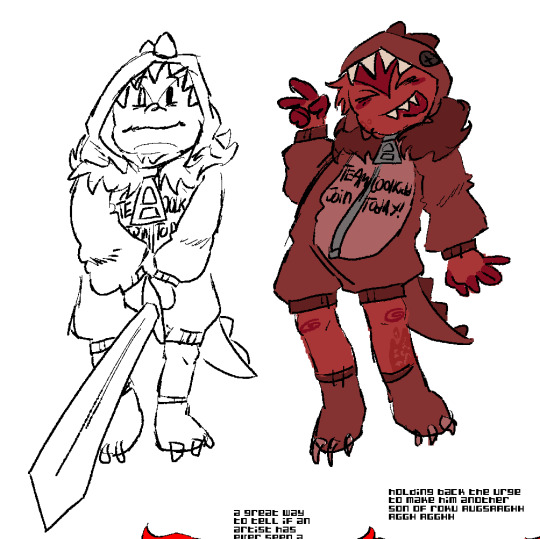

look at my weird freak creature thang . my son + a refrence for myself for his pattern/layout of his eczema yuuuppp you know i heard skin condition and went projection mode
#onlu real ones will know roku bro#hes kind of gotten squashed cause the canon of regretevator doesnt suit him anymore#i mean that and theres already a guest 666 in this universe.. ill need to look more into him and his lore if i even want to consider-#inserting my little bug freak into it#hes like the thread that ties all my roblox fixations together#except for dandys world#since it just uses roblox as a platform#and doesnt refrence it in any way#anywho .#artsharkz#forsaken#homicidal porkchops#homicidalporkchops#forsaken roblox#forsaken fanart#c00lkidd#forsaken c00lkidd#c00lkidd forsaken
137 notes
·
View notes
Text

A MASTERLIST OF ALL THE BOOKS I COULD FIND IN TIM'S BOOKSHELVES
As someone who basically sees Tim Laughlin as my own version of Jesus Christ (I kind of wish I was lying but I have a 'beyond measure' tattoo branding my skin so perhaps I'm entirely serious), I simply needed to know what was on those shelves of his. And this was a hard task to achieve, believe me... but I got much farther than I initially thought I would.
(I've got so much to say about all of these books and how they might string together to create a deeper understanding of Tim as a character but I won't go into it here... maybe in a future post or video essay, who knows).
If you wish to help a girl out and attempt to figure out any of the other books I simply can not crack no matter how I look at the screenshots and mess with the adjustments... here's a folder full of 2k sized screenshots of those shelves.
Before I list the books one by one, I want to make a couple observations:
1) Almost all of the books I was able to pinpoint are non-fiction. The ones that aren't are children's books.
2) Topically, we see an interdisciplinary interest in:
History: from a book on a king in 4BC, to a survey of landholding in England in the 11th century.
Somewhat current historical events: books on World War I and II.
Western Philosophers: specially from the 16th to the 18th century.
Aesthetics: there's at least 2 books on the subject matter, but I couldn't find the second one, sadly.
Spirituality: not only christian/catholic; some of these books touch on Eastern practices such as Buddhism and Hinduism.
Fairy tales / children's books.
Psychology: specially in regards to mysticism and sexuality.
Science and scientific discovery/research.
3) A lot of the history, current events, and spirituality books are autobiographies/memoirs.
4) A lot of books (specially those on sciences and philosophy) tend to be more so anthologies or overviews on a subject matter rather than a book written by one specific author on one very concrete topic.
Overall, this all reflects very well an idea Jonathan Bailey himself expressed in a brilliant interview you can watch here if you haven't yet:
"Tim has buddhist flags in his 1980s flat in San Francisco, he has crystals, he is someone who is always seeking other ways to understand human experience. Which is probably tiring for him. Throughout the decades, he sort of appears as completely different people. At the crux of it there's this extreme grinding, contrasting, aggressive duality between feeling lovable and not feeling lovable. There's such shame in Tim. But it's the push and the pull which keeps him alive.”
This desire to understand human psychology, spirituality, and the ways of the universe through as many diverse lenses as possible, as well as a predilection for non-fiction, expresses very much to me that insatiable thirst for truth that defines his character so strongly.
OKAY, THAT BEING SAID. Here's the list in chronological order of publication.
PS. if you decided to click on any of the following titles it'd definitely not take you to a google drive link of the pdf file where you could download and read these books for yourself. Because that would be illegal and wrong.

Journeys through Bookland by Charles H. Sylvester (1901?) (1922 Edition)
I don't know which specific volume he owns, sorry, I tried my best but the number is not discernible (hell, the title barely is). If anyone wants the download link to these hmu because I'm not about to individually download all 10 right now.
10 volumes of poems, myths, Bible stories, fairy tales, and excerpts from children's novels, as well as a guide to the series. It has been lauded as ‘a new and original plan for reading, applied to the world’s best literature for children.’
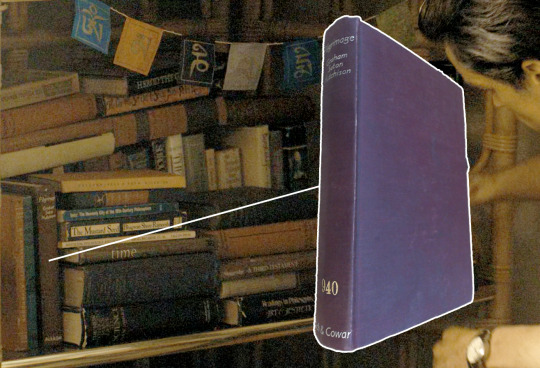
Pilgrimage by Graham Seton Hutchison (1936)
This book provides a view of the battlefields of WW I through the eyes of the average fighting man.
One curious thing about this book is that it's author, a British First World War army officer and military theorist, went on to become a fascist activist later in his life. Straight from Wikipedia:
"Seton Hutchison became a celebrated figure in military circles for his tactical innovations during the First World War but would later become associated with a series of fringe fascist movements which failed to capture much support even by the standards of the far right in Britain in the interbellum period." He made a contribution to First World War fiction with his espionage novel, The W Plan."

The Seven Storey Mountain by Thomas Merton (1948)
The Seven Storey Mountain tells of the growing restlessness of a brilliant and passionate young man, who at the age of twenty-six, takes vows in one of the most demanding Catholic orders—the Trappist monks. At the Abbey of Gethsemani, "the four walls of my new freedom," Thomas Merton struggles to withdraw from the world, but only after he has fully immersed himself in it. At the abbey, he wrote this extraordinary testament, a unique spiritual autobiography that has been recognized as one of the most influential religious works of our time. Translated into more than twenty languages, it has touched millions of lives.
This book requires no introduction. It's the one he keeps the Fire Island's postcard in and the one we see him re-reading in episode 8 after Hawk brings it to the hospital with him at the end of episode 7.
Just a little detail I noticed:
Apparently he liked the book so much he visited Gethsemani, which was the home of its author all the way up till 1968.

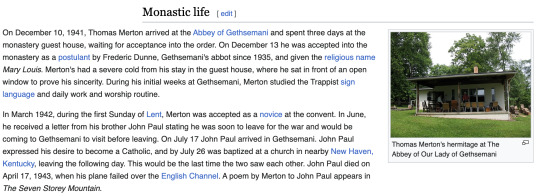
For all we know, he might have even met its author!

Sexual Behavior in the Human Male by Alfred Charles Kinsey, Wardell B. Pomeroy (1948)
When published in 1948 this volume encountered a storm of condemnation and acclaim. It is, however, a milestone on the path toward a scientific approach to the understanding of human sexual behavior. Dr. Alfred C. Kinsey and his fellow researchers sought to accumulate an objective body of facts regarding sex. They employed first hand interviews to gather this data. This volume is based upon histories of approximately 5,300 males which were collected during a fifteen year period. This text describes the methodology, sampling, coding, interviewing, statistical analyses, and then examines factors and sources of sexual outlet.
Yes, Charles Kinsey is indeed behind the Kinsey scale that has done so much for the LGBTQ+ community.

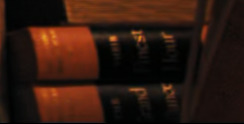
Their Finest Hour (1949), The Grand Alliance (1950), and Closing the Ring (1951) by Winston Churchill
Winston Churchill's six-volume history of the cataclysm that swept the world remains the definitive history of the Second World War. Lucid, dramatic, remarkable both for its breadth and sweep and for its sense of personal involvement, it is universally acknowledged as a magnificent reconstruction and is an enduring, compelling work that led to his being awarded the Nobel Prize for literature in 1953.
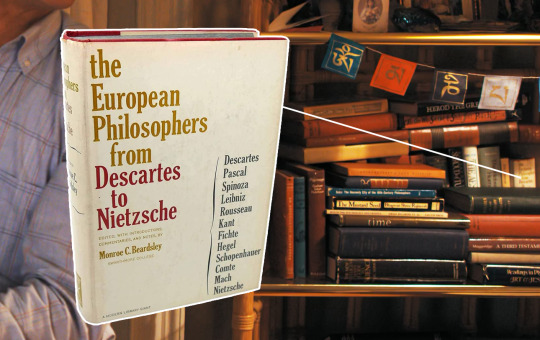
The European Philosophers from Descartes to Nietzsche by Monroe C. Beardsley (1960)
In so far as we reflect upon ourselves and our world, and what we are doing in it, says the editor of this anthology, we are all philosophers. And therefore we are very much concerned with what the twelve men represented in this book--the major philosophers on the Continent of Europe--have to say to us, to help us build our own philosophy, to think things out in our own way. For the issues that we face today are partly determined by the work of thinkers of earlier generations, and no other time is more important to the development of Western thought than is the 250-year period covered by this anthology. Monroe. C. Beardsley, Professor of Philosophy at Swarthmore College, has chosen major works, or large selections from them, by each man, with supplementary passages to amplify or clarify important points. These include: Descartes - Discourse on Method (Descartes), Thoughts (Pascal), The Nature of Evil (Spinoza), The Relation Between Soul and Body (Leibniz), The Social Construct (Rousseau), Critique of Pure Reason (Kant), The Vocation of Man (Fichte), Introducciton to the Philosophy of History (Hegel), The World as Will and Idea (Schopenhauer), A General View of Positivism (Comte), The Analysis of Sensations and the Relation of the Physical to the Psychical (Mach), Beyond Good and Evil (Nietzsche).
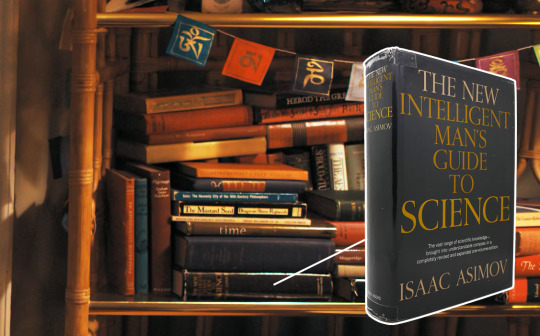
The New Intelligent Man's Guide to Science by Isaac Asimov (1965)
Asimov tells the stories behind the science: the men and women who made the important discoveries and how they did it. Ranging from Galilei, Achimedes, Newton and Einstein, he takes the most complex concepts and explains it in such a way that a first-time reader on the subject feels confident on his/her understanding. Assists today's readers in keeping abreast of all recent discoveries and advances in physics, the biological sciences, astronomy, computer technology, artificial intelligence, robotics, and other sciences.
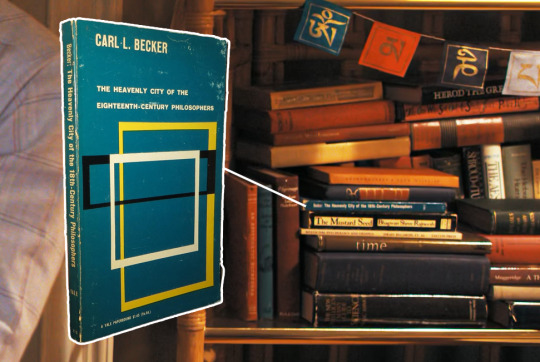
The Heavenly City of the 18th Philosophers by Carl L. Becker (1932) (1962 reprint)
Here a distinguished American historian challenges the belief that the eighteenth century was essentially modern in its temper. In crystalline prose Carl Becker demonstrates that the period commonly described as the Age of Reason was, in fact, very far from that; that Voltaire, Hume, Diderot, and Locke were living in a medieval world, and that these philosophers “demolished the Heavenly City of St. Augustine only to rebuild it with more up-to-date materials.” In a new foreword, Johnson Kent Wright looks at the book’s continuing relevance within the context of current discussion about the Enlightenment.
I find the particular choice of adding this book very curious and on brand, since it explores the idea that philosophers of the Enlightenment very much resembled religious dogma/faith in their structure and purpose. Just... A+ of the props department to not just add any kind of book on philosophy anthology.

Herod The Great by Michael Grant (1971)
The Herod of popular tradition is the tyrannical King of Judaea who ordered the Massacre of the Innocents and died a terrible death in 4 BC as the judgment of God. But this biography paints a much more complex picture of this contemporary of Mark Antony, Cleopatra, and the Emperor Augustus. Herod devoted his life to the task of keeping the Jews prosperous and racially intact. To judge by the two disastrous Jewish rebellions that occurred within a hundred and fifty years of his death -- those the Jews called the First and Second Roman Wars -- he was not, in the long run, completely successful. For forty years Herod walked the most precarious of political tightropes. For he had to be enough of a Jew to retain control of his Jewish subjects, and enough of a pro-Roman to preserve the confidence of Rome, within whose territory his kingdom fell. For more than a quarter of a century he was one of the chief bulwarks of Augustus' empire in the east. He made Judaea a large and prosperous country. He founded cities and built public works on a scale never seen before: of these, recently excavated Masada is a spectacular example. And he did all this in spite of a continuous undercurrent of protest and underground resistance. The numerous illustrations presents portraits and coins, buildings and articles of everyday use, landscapes and fortresses, and subsequent generations' interpretations of the more famous events, actual and mythical, of Herod's career.
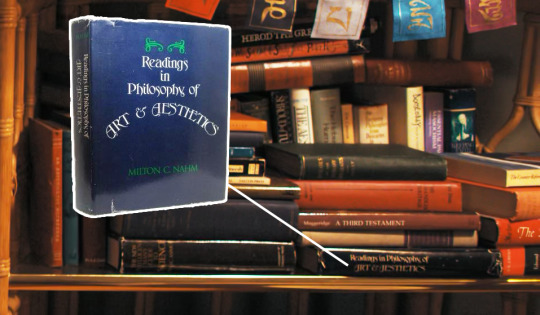
Readings in the Philosophy of Art and Aesthetics compiled by Milton Charles Nahm (1975)
A college level comprehensive anthology of essays written on the arts and the field of aesthetic philosophy.

The Mustard Seed: Discourses on the Sayings of Jesus Taken from the Gospel According to Thomas by Bhagwan Shree Rajneesh (1975)
This timely book explores the wisdom of the Gnostic Jesus, who challenges our preconceptions about the world and ourselves. Based on the Gospel of Thomas, the book recounts the missing years in Jesus’ life and his time in Egypt and India, learning from Egyptian secret societies, then Buddhist schools, then Hindu Vedanta. Each of Jesus' original sayings is the "seed" for a chapter of the book; each examines one aspect of life — birth, death, love, fear, anger, and more — counterpointed by Osho’s penetrating comments and responses to questions from his audience.
(You don't know how fulfilling it was to find some of these books and just sit there like "oh my god, yessss, he'd SO read that".)
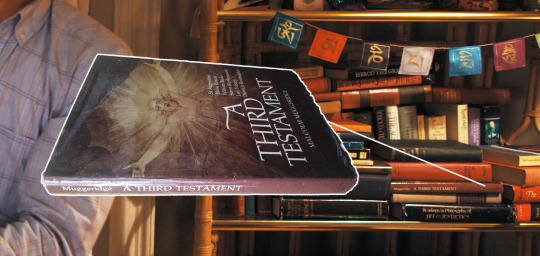
A Third Testament by Malcolm Muggeridge (1976)
A modern pilgrim explores the spiritual wanderings of Augustine, Pascal, Blake, Kierkegaard, Dostoevsky, Tolstoy, and Bonhoeffer. A Third Testament brings to life seven men whose names are familiar enough, but whose iconoclastic spiritual wanderings make for unforgettable reading. Muggeridge's concise biographies are an accessible and manageable introduction to these spiritual giants who carried on the testament to the reality of God begun in the Old and New Testaments. - St. Augustine, a headstrong young hedonist and speechwriter who turned his back on money and prestige in order to serve Christ - Blaise Pascal, a brilliant mathematician who pursued scientific knowledge but warned people against thinking they could live without God - William Blake, a magnificent artist-poet who pled passionately for the life of the spirit and warned of the blight that materialism would usher in - Soren Kierkegaard, a renegade philosopher who spent most of his life at odds with the church, and insisted that every person must find his own way to God - Fyodor Dostoevsky, a debt-ridden writer and sometime prisoner who found, in the midst of squalor and political turmoil, the still small voice of God - Leo Tolstoy, a grand old novelist who swung between idealism and depression, loneliness and fame and a duel awareness of his sinfulness and God s grace - Dietrich Bonhoeffer, a pastor whose writings and agonized involvement in a plot to kill Hitler cost him his life, but continue to inspire millions
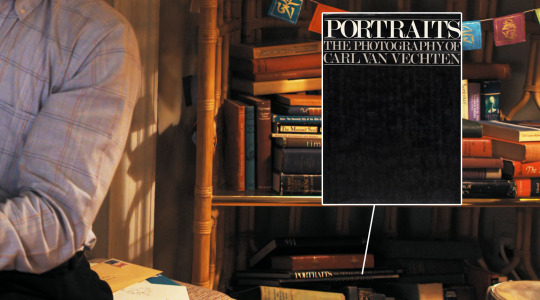
Portraits: The photography of Carl Van Vechten (1978)
Can't find a file but you can borrow it from archive.com in the link provided.
During his career as a photographer, Carl Van Vechten’s subjects, many of whom were his friends and social acquaintances, included dancers, actors, writers, artists, activists, singers, costumiers, photographers, social critics, educators, journalists, and aesthetes. [...] As a promoter of literary talent and a critic of dance, theater, and opera, Carl Van Vechten was as interested in the cultural margin as he was in the day’s most acclaimed and successful people. His diverse subjects give a sense of both Carl Van Vechten’s interests and his considerable role in defining the cultural landscape of the twentieth century; among his many sitters one finds the leading lights of the Harlem Renaissance, the premier actors and writers of the American stage, the world’s greatest opera stars and ballerinas, the most important and influential writers of the day, among many others.
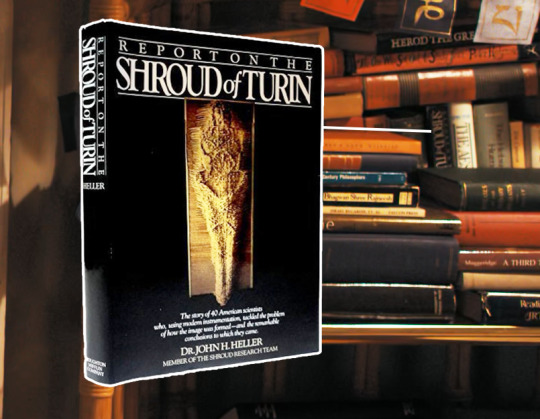
Report of the Shroud of Turin by John H Heller (1983)
Heller, while a man of science, was nevertheless a devout man (Southern Baptist). He viewed his task concerning The Shroud with great scepticism; there have been far too many hoaxes in the world of religion. The book describes in great detail the events leading up to the team's conviction that the Shroud was genuine; last - not least - being Heller and Adler's verification of "heme" (blood) and the inexplicable "burned image" of the crucified man. Although carbon dating indicates that the image is not 2000 years old and that the cloth is from the Middle Ages, there is not enough evidence to disprove Heller's assertion that the Shroud is indeed genuine.
Context for those who may not know (though I doubt it's necessary): The shroud of Turin "is a length of linen cloth that bears a faint image of the front and back of a man. It has been venerated for centuries, especially by members of the Catholic Church, as the actual burial shroud used to wrap the body of Jesus of Nazareth after his crucifixion, and upon which Jesus's bodily image is miraculously imprinted."
It is a very controversial subject matter and I definitely don't know that from going to an Opus Dei school since the day I was born till the day I graduated high school.

Mysticism, Psychology and Oedipus by Israel Regardie (1985)
I've tried my hardest but despite many Israel Regardie books being on the world wide web, I can't find a copy of this specific one.
Mysticism, Psychology and Oedipus, from the Small Gems series is one of these mysterious alchemys which Regardie and Spiegelman crafted for the serious student of mysticism. Mysticism, Psychology and Oedipus by Dr. Israel Regardie and his friend, world renowned Jungian Psychologist, J. Marvin Spiegelman, Ph.D. was created to reach the serious student at the intersecting paths of magic, mysticism and psychology. While each area of study overlaps they also maintain their own individual paths of truth. One of Regardie’s greatest gifts was his rare ability to combine these difficult and diverse subjects and make them understandable.
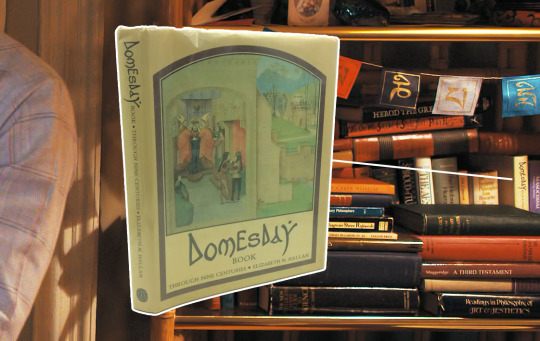
Domesday Book Through Nine Centuries by Elizabeth M. Hallam (1986)
In 1086 a great survey of landholding in England was carried out on the orders of William the Conqueror, and its results were recorded in the two volumes, which, within less than a century, were to acquire the name of Domesday, or the Book of Judgment 'because its decisions, like those of the last Judgment, are unalterable'. This detailed survey of the kingdom, unprecedented at that time in its scope, gives us an extraordinarily vivid impression of the life of the eleventh century.
The following two are a fuck up on the props department part because they were published after 1987 but we'll forgive them because they were not expecting for me to do all this to figure out the titles of these books, I'm sure:
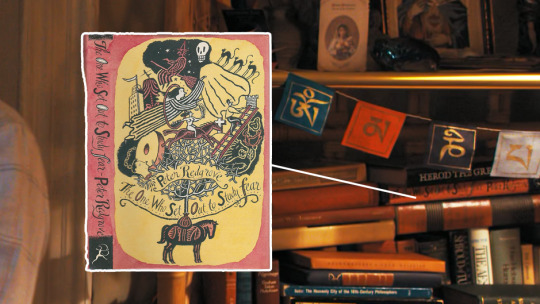
The One Who Set Out to Study Fear by Peter Redgrove (1989)
This book barely exists physically, rest assured it does not exist online... LOL.
The author of The Wise Wound presents here a re-telling of Grimm's famous fairy tales, written in a manner and spirit more suited to the present day. Each story is rooted in the original, but cast in an energetic style that is both disrespectful and humorous.
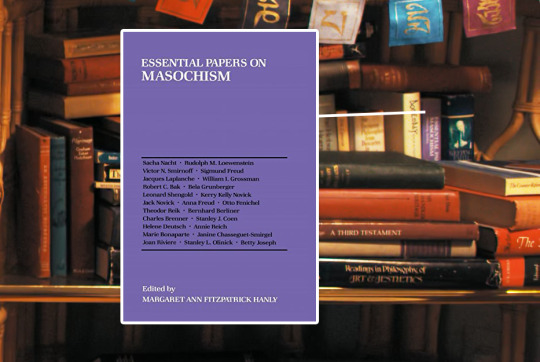
Essential Papers on Masochism by Margaret Ann Fitzpatrick Hanly (1995)
The contested psychoanalytic concept of masochism has served to open up pathways into less-explored regions of the human mind and behavior. Here, rituals of pain and sexual abusiveness prevail, and sometimes gruesome details of unconscious fantasies are constructed out of psychological pain, desperate need, and sexually excited, self- destructive violence. In this significant addition to the "Essential Papers in Psychoanalysis" series, Margaret Ann Fitzpatrick Hanly presents an anthology of the most outstanding writings in the psychoanalytic study of masochism. In bringing these essays together, Dr. Fitzpatrick Hanly expertly combines classic and contemporary theories by the most respected scholars in the field to create a varied and integrated volume. This collection features papers by S. Nacht, R. Loewenstein, Victor Smirnoff, Sigmund Freud, Jacques Laplanche, Robert Bak, Leonard Shengold, K. Novick, J. Novick, S. Coen, Margaret Brenman, Esther Menaker, S. Lorand, M. Balint, Bernhard Berliner, Charles Brenner, Helene Deutsch, Annie Reich, Marie Bonaparte, Jessica Benjamin, S.L. Olinick, Arnold Modell, Betty Joseph, and Janine Chasseguet-Smirgel.
Let's not forget another book we know has been present in his shelves at some point:

Look Homeward, Angel by Thomas Wolfe (1929)
It is Wolfe's first novel, and is considered a highly autobiographical American coming-of-age story. The character of Eugene Gant is generally believed to be a depiction of Wolfe himself. The novel briefly recounts Eugene's father's early life, but primarily covers the span of time from Eugene's birth in 1900 to his definitive departure from home at the age of 19. The setting is a fictionalization of his home town of Asheville, North Carolina, called Altamont in the novel.
And Ron Nyswaner mentioned in a podcast (might be this one? I'm not sure) that he scrapped from the script a line where Tim recommends this poem at some point:
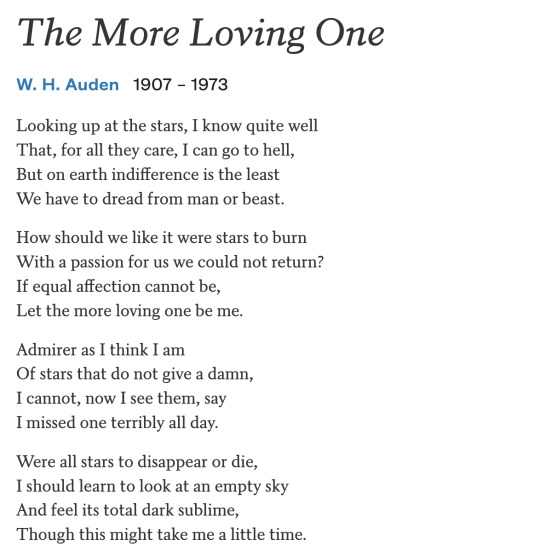
He specially emphasized the line "If equal affection cannot be, Let the more loving one be me".
And lastly, if anyone wanted to know:
His copy of the bible is the Revised Standard Version by Thomas Nelson from either 1952 or 1953.
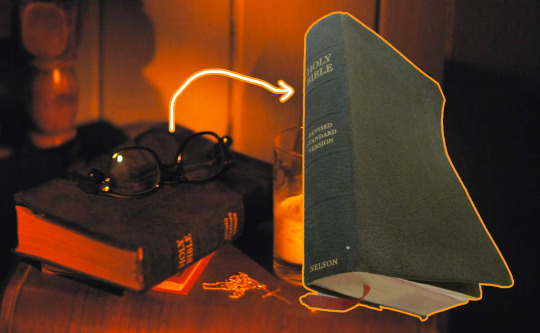
Because why the hell not figure out what specific translation of the holy bible a fictional character was basing his beliefs on — as if the set designers cared nearly as much as I do.
#fellow travelers#fellow travelers meta#tim laughlin#fellowtravelersedit#i know it doesnt precisely fit the tag but hey.. theres a gif right there#this is such a jobless thread... but i AM jobless
151 notes
·
View notes
Text


i'm cooked i fear
#《 ooc. 》#aight i'm done insane man posting#it's happening now#when theres a character who has several reddit threads on ppl talking how much they hate him#that's when i know that's my character
15 notes
·
View notes
Text
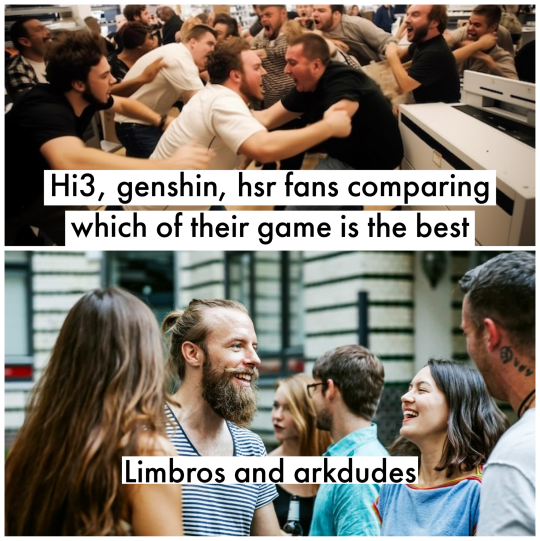
Why is it that fandoms with their games made by the same company hate each other so much whereas this is the opposite?
#project moon#limbus company#library of ruina#honkai impact#lobotomy corp#arknights#im in honkai 3rd fandom and limbus fandom and i tell you there should be atleast more than one drama of hyv fandom starting a war#whereas theres atleast on twt thread of unclefucker discussion between limbus and arknights#hoyoverse#mihoyo#genshin impact#honkai star rail#atleast ggz is seperate from this shitshow#i should try arknights while waiting for the pm drama to end#the friendship between limbus fandom and arknights fandom is the most random thing yet wholesome shit i’ve ever seen#is this what fame did to game company#i know pm and hypergryph are famous to but lets be real here hyv literally dominate the gacha game#apart from type moon obviously#prove thst found family is healthier than actual family#hi3rd is like the underdog despite its also famous but we just got drag into this fight
217 notes
·
View notes
Text
In the ongoing battle between Lisa 'I-need-to-fix-it' Swain and Carla 'I-need-to-fix-her' Connor, many, many sapphic lives have been lost.
It's us
Losing our lives while watching them play roulette with theirs

#swarla#carla x lisa#carla connor#lisa swain#What even-#*dry heaving*#*leans against the wall*#*eyes the railings*#*flops over it*#This week has been 84 long years and it's fucking Tuesday#I think I need help after that feed of angst-fuelled near-misses that keep spiraling into even worse possibilities#'I don't just mean tonight'#Dkdiejifws#theres so much going on#Where to even begin unpicking the horrors#Though some of you are yanking those threads really. FuCking. HARD#Ye know who ye are#Unhinged eloquent souls#Anybody got another hospital bed going spare?#Not just for me#some of you need help
17 notes
·
View notes
Text
I feel like I'm insane why are none of the hw2 update theories talking about the connections of 3 star with mxes and how its plausible they're driving the van pre-ruin it's right there it's not even hidden or hard to piece together its SO obvious. SO MUCH evidence points towards it. itd make perfect sense too. the gift shop and the van are grouped together bc its saying that mxes came from the factory, probably built by Edwin, and 3 star took them to set up ruin, their footprints around ruin where nodes are + Gregory's backpack by mxes + his knowledge about mxes making it painfully clear. it reveals where mxes came from easily. all information it could convey is here.
they all just keep saying "someone" or "they're taking mxes post ruin or it's back in the 70s or it's the van that hit david (SO many plotholes with that)" like oh my god i swear everything has to be about the mimic/tftp and Gregory and vanessa dont exist if they arent actively vanny and ggy in the YouTube theory community. why will nobody actually observe in game evidence. theres so many obvious plotholes that nobody but me sees with it being the van that hit david and it's making me feel insane
#im sorry im so bothered#its not even that theyre all sayinf something equally plausible they just. arent looking into it#or taking it painfully surface level#without looking ANY deeper whcuh. this is a theory video why would you not do that#just toss around that this van is the one that hit david even though the van isnt even white and theres a fucking ginormous plothole#if that were the case#john please gaf soon please come save us nobody else wohld understand but you#and i know he still understands bc he foesnt even want to make theories about sotm bc hes real asf#theres nothing to theorize about its all already in the books. i stg least engaging fnaf release ever#sorry my haterisms are coming out#3 star is so fucking obviously being connected to mxes with a red thread with obvious not difficult to find evidence in the games#and nobody will acknowledge it its bothering me so bad#pandas.txt#discourse
23 notes
·
View notes
Text
biggest downside of not having many experiences or meeting many people is not having anything to feed into the art machine
#i think this is what i really mean when i say i dont have the artist's mind#i like drawing and am learning to enjoy how i draw#but beneath the lines i dont really know how to make anything meaningful#i wish i could experience the brain of another artist for this reason like#i didnt do much as a kid didnt watch or play many things didnt meet many people i read quite#a bit but nothing really stuck never learned much in school bc id always just draw#is this why i have nothing even now at 26 living almost the same life?#i cant cobble together a story or background for my characters i cant make stuff that Means anything#i always talk also about how i fear finding a partner bc my stuff is just 99% self indulgent sanity keeping work#idk what id make without the lonely#i dont even know what to make With the lonely but its all thats here#<- this part is only barely related but theres a connection there ykwim#talkys#ive never felt anything good or bad in either direction...not much to draw from ...#i know i dont NEED my ocs to have roles in a novel but it just gets embarrassing at some point#ppl take interest in talon and i cant put together anything interesting there's nothing in my brain#i cant connect threads i cant think outside of the box#alas! alas#i think its just always going to be one of those immutable things 😞 too late to rewire rhe brain#especially since the monotony and captivity is ongoing.#goodnite ^_^
47 notes
·
View notes
Text

/ I feel like my current struggle when it comes to this blog (or any of my multis but specifically this one, bc with my j.ojo's I'm vibing) is that I do have the passion for my characters, but my attention is all over the place because I have too many interests, too many muses, and all my muses come from very different backgrounds where there's a lot of nuances and history and culture behind each of them that are miles apart; think of having to jump from greek mythology and all its pantheon of gods, to aztec mythology and its religion to then indian mythology to then Maya mythology, and then japanese history and etc etc and back and forth all the time while trying to keep it accurate to the muse's fictional story but offering these lil tidbits here and there of their backgrounds;; it's also why there are some cases where I have to go back and re-read a lot of stuff because I'm remembering only fractions (example; vlad III)
so in conclusion it's like;; for as much as I love history and love reading about it;; at the end of the day it's also a LOT of information that goes into each of my muses and the way I seek to portray them; which in some way, I'm also being a bit too perfectionist about it all (I am not an historian after all, nor do I seek to write accurate historical depictions either) hence why you probably can't see much writing in terms of threads and the such; lately I mostly just reblog a lot of stuff;; BUT YEAH- just some self reflection :thonks:
#;ooc#ooc#its like im lacking on the actual 'r.p schedule/etiquette' i dont answer asks nor write threads nor etc etc#in conclusion; this is why i write one in a blue moon OUETHIERUBHRUGHR#also english is not my native tongue and sometimes the day isnt englishing you see#but its also not spanishing either;; my mind is BLANK#i start going 'and he said and he did and he went and he and he and he-' OIUGHRAAAAAAHJJJJHH#which is totally fine on itself but i want to write like;; more descriptively#IT'S ALSO WHY- i had so many f.go solo blogs too; bc i could just focus on them and only them for that time i was logged there#what i love about multis is the flexibility;; especially for someone like myself who has a lot of interests#i can have them all in one place; so its really good in that regards#but at the same time; it makes me get too distracted; like theres so much on the table i just sit there thinking mmmmm who to pick-#-takes 50 hours-#U GET IT---#i dont know how to fix this tbh;; i think the key is to just let it go and dont be too much of a perfectionist since its a hobby and#all that stuff#but---- (insert a.rjuna complex)#me when it doesnt fit an inch of my standards: im going to release my final croar-#jkjk- unless-#im just going to start replying to stuff as one liners; that will teach me a lesson#there's also this thing about;; 'paragraph etiquette' of old rpc days l.ionfanged / e.rika was talking about#that you feel that if you dont write a reply with tons of paragraphs; u get the guilt that 'oh they will think im not as into this#-as they are'#GRAGHRAAAAAAAAAAAAAAAAAAAAARRGRGGHH#AWFUL#im going to start replying with gifs only to train my brain to let it GO#anyways i miss d.iego b.rando...
10 notes
·
View notes
Text
A friend of a friend is looking to raise $3550 before the end of the year - big bill, you know the story. If any of you could help him out i'd appreciate it.

#crowdfunding#mutual aid#i know this dude and he's cool but i know him through someone else. yk how it is#theres more info in the tweet threads
143 notes
·
View notes
Text
does anyone know how to do threads on bluesky? 😭 its probably so simple but i dont wanna fuck it up. the image max is 4 but i wanna add another related one and i think a thread is the correct way to do that?
#i never used twitter so i have like no frame of reference for this..#theres a repost/quote post thing at the bottom that i can click on my own post but i dont know if that makes it a thread#sorry for super basic questions but if anyone could help id be grateful 🙏
13 notes
·
View notes
Text
some random canon things i have to have on this blog / remind everyone of
bucky was a child soldier and specifically molded to be one. he was 15 at training and 16 when sent into the field. he was picked specifically to do the dirty work that they did not want steve to do; he's always been an assassin
bucky didn't trust wolverine and tried to kill him, twice, as a teenager
bucky has 1v1'd a giant brown grizzly bear (who is actually a person who turns into one)
bucky is responsible for the assassination of jfk. if you glance at his wiki its one of the first things you'll see
bucky appears to have some kind of telepathic / innate connection to his arm, as there is a comic where when it was severed it crawled around and attacked people
bucky kills people, and does not give a fuck if you're a woman or old or both. see this page. the ass whoopings are equally handed out.
bucky's weapons are biometrically connected to him, specifically. if anyone else tries to use them, they'll explode on them.
bucky once shot horseman apocalypse red hulk through the eye with a pistol from a ridiculous distance.
bucky's sniper rifle can travel a moon away.
bucky cut one of barton's arrows in half, while it was in flight, with his natal hand.
#theres a whole list of impressive shit bucky's done in one of the 'respect x' reddit threads which i'm always super thankful for#but these are a few i remember lmao#these just tickle me you know.#HEADCANON.#actual canon but
19 notes
·
View notes